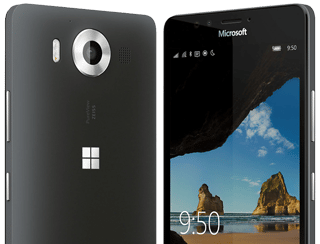Microsoft Lumia 950: It Could Be Better

The Lumia 950 is Microsoft’s attempt to turn your phone into something like a full-on Windows PC. It is built to move you to the next level of worker productivity. Unfortunately it comes up a little short.
The first Windows 10 device is designed to extend the benefits of the Windows experience
to the smartphone. The goal is to use the phone to power a desk type experience to a monitor. This includes syncing office documents and photos across all your devices and connecting with the Windows store so your favorite apps, game, music and video are all in one place.
On the plus side, the phone does have a nice quad HD display, 5.2 inches, 564 pixels per square inch. USB-C for fast charging and a large capacity battery. The attractive display is easy to read outdoors. It is scratch resistant with a strong display glass.
Photo quality is on-par with the best smartphones. “Rich Capture” provides a triple LED natural flash. You can adjust the color saturation levels of bright or dark areas. A 20 MP sensor attempts to virtually eliminate motion blur. The quality camera image holds up even in low light.
The phone is constructed of plastic, a negative for some. The battery can be removed and it does has a microSD card slot which many phones do not. The Cortana voice assistant is also included.
Microsoft’s secret sauce to all this is the Windows Continuum. The goal is to connect your Lumia 950 to a Microsoft Display Dock and use it with an external monitor, keyboard and a mouse. Office apps and Outlook can be scaled up to create a big screen optimized work environment. The idea is maintain productivity even without a laptop.
The Continuum feature is not really available in Android or iPhone devices. It will take some finesse to get it set up and some experimentation with the right type of cables etc. to make it work.
Once you have it together and working, whether it be in a hotel room or conference area, you can share a PowerPoint presentation or a video on large screen. When done you can undock your phone. Then you can resume working on the same project in a matter of minutes.
Many report problems with typing on the device. Automated spell check is not available. It will take longer to correct errors.
Windows 10 brings a few other additions to the Lumia 950. One is Windows Hello, now in beta mode. Hello is iris-scanning recognition software. It works by just staring into the phone.
App selection for a Windows phone still remains challenging. The platform is not supported by Google. Those who rely on Gmail, Google Maps, Google Drive, and Google Docs will have to find third party applications or go directly to the web for usage.
Pricing starts at $550 in the U.S. and will be determined by carrier. A larger 5.7” inch XL version is scheduled to be introduced later and will cost more.
The 950 is a good start for Microsoft to bring more productivity to the smartphone, but not the end result many were expecting. Unfortunately the design is not really anything new, Continuum set-up can be challenging, and a lack of apps is troublesome.
Windows fans may seize the opportunity to jump on the Lumia bandwagon and work through some of the phone’s shortcomings.
Others will wait until Microsoft fixes some of the inherit problems with not only the phone but the Continuum system itself before giving it a more serious look.


